Breast Enlargement (Augmentation)
The following information sheet is intended to assist patients preparing for breast enlargement (augmentation) surgery with Dr Nicholas Lotz.
-
Plastic Surgery
Breast Surgery
-
Tags
Breast Augmentation
Breast Augmentation Surgery
Breast augmentation is a commonly performed procedure that increases the volume of the breasts.
This surgery aims to increase the breast size so that they are more in proportion with the rest of your body, or to restore fullness to the breasts that is lost after breast feeding, weight loss, or with age.
Dr Lotz aims to provide natural results in a caring and safe environment.
The decision to have breast implants is not a small one. Dr Lotz will personally walk you through all the surgical options in his detailed initial consultation. During that time he will advise you what implants will be best to fit your body shape and achieve your desired results.
All patients will have a second meeting with Dr Lotz before surgery to answer additional questions and choose a final implant size.
Before the
surgery
During your initial consultation, Dr Lotz will spend time with you discussing your general health, current problems, and what breast size you would ideally like to be following the surgery. All patients have slightly different requirements, and will require their breast surgery to be tailored to their needs.
Dr Lotz will explain in detail what is required in your case, and the relevant risks and expected recovery will be discussed. You will be shown photographs of other patients who have undergone similar surgery, so you have an idea what to expect with respect to results.
You will be sent an information pack further explaining the procedure, along with a detailed, personalised quotation which explains all the relevant costs pertaining to the procedure.
It is important that you stop any blood thinning medications at least 10 days prior to surgery in order to reduce the risk of bleeding.
You should also cease smoking a month before and a month after your surgery to reduce the risk of skin healing problems.
You will have a second consultation a week or two prior to your surgery to answer any final questions you may have, and photographs will be taken to aid planning your surgery. At this consultation the final decision about you breast implant will be made.
The surgery
Breast Implant Placement
Dr Lotz always performs breast augmentation under general anaesthetic, in an accredited hospital and using a qualified and experienced anaesthetist. It is important that your surgery is performed in a safe environment which enables results to be as predictable as possible.
You will have the option to either go home that day or stay one night in hospital.
Breast Implant Placement
Breast Implant - Surgical Incision
Breast implants may be placed via a variety of surgical incisions which include in the fold below the breast (most common), around the nipple or in the armpit. The preferred incision used by Dr Lotz is in the fold under the breast, as this provides the best visualisation for the surgery and also means less implant contact with the breast tissue during the surgery, which decreases the rate of future problems.
Breast Implant - Position
The implants can be positioned either underneath the pectoral muscle or above the muscle directly beneath the breast tissue. If you are quite thin then it is best to position the implants under the muscle so that the edge of the implant is less likely to show. Dr Lotz can advise you which positioning would be the most appropriate in your case, and discuss the advantages and disadvantages of each option.
Breast Implant Placement
Breast Implant Placement
Breast Implant Placement
Breast Implant - Surgical Incision
Breast implants may be placed via a variety of surgical incisions which include in the fold below the breast (most common), around the nipple or in the armpit. The preferred incision used by Dr Lotz is in the fold under the breast, as this provides the best visualisation for the surgery and also means less implant contact with the breast tissue during the surgery, which decreases the rate of future problems.
Breast Implant - Position
The implants can be positioned either underneath the pectoral muscle or above the muscle directly beneath the breast tissue. If you are quite thin then it is best to position the implants under the muscle so that the edge of the implant is less likely to show. Dr Lotz can advise you which positioning would be the most appropriate in your case, and discuss the advantages and disadvantages of each option.
Type of Breast Implant
Silicone on Saline implants?
Dr Lotz uses only silicone gel-filled implants which are made by companies with long standing safety records. Despite the concerns over silicone breast implants in the 1970’s, studies have since shown that there is no increased risk of the development of cancer, immunologic or neurological problems associated with the use of silicone breast implants. Modern silicone implants are made of a “cohesive gel” which is a bit like set jelly and will hold its shape even when it is cut in half. This gel is covered with a thick, textured envelope that can help to decrease the risk of capsule formation around the implant (which may cause distortion and hardening of the implant).
Breast Implant Shape
Breast implants come in either round or “anatomical” shape. The anatomical implants are shaped like a teardrop when seen from the side, which attempts to mimic the normal shape of a breast. Dr Lotz can advise the relative advantages of each of these choices, and help you decide which is most suitable for you. In most cases, patients with very little breast tissue at all will do best with an anatomically shaped implant to give the most natural result.
At the end of the surgery, local anaesthetic will be put into the implant pockets to decrease postoperative pain and the incisions will be closed with dissolving stitches to minimise scarring. A waterproof dressing will be applied so you will be able to shower normally. You will be given a custom made bra to wear when you go home.
Dr Lotz does not use surgical assistants so you can be assured that all of the surgery and every stitch will be personally done by him.
After the surgery
Post-operative Recovery and Care
Your breasts are usually a bit swollen and tender after the surgery, and may feel a bit tight for a few days. There is often some numbness of the breasts which resolves in the following weeks.
Most patients will be back at office work in about a week, whilst more involved work may require 10-14 days off. You will be able to drive after a week.
It is usually best to avoid any strenuous activity for a month, but gentle exercise can be resumed after a couple of weeks. You will be back to full activity 6 weeks after the surgery. You will be given surgical tape on the scars for 3 months in order help to minimise the scarring for the best possible aesthetic result.
Follow-Up Care
You will be seen in the rooms a week after surgery to check everything is healing normally and answer any questions you may have. You will then be seen about a month following surgery and then again 3-4 months after surgery. During all of these appointments you will see Dr Lotz to ensure all of your questions are answered.
Breast self-examinations, mammograms and breast feeding
As breast implants are always behind the breast tissue, you will be able to continue regular breast self-examination after the surgery. Patients with breast implants are still able to have mammograms and you are able to breast feed.
Risks of breast augmentation
- Anaesthetic (nausea, vomiting, allergies, clots in the legs)
- Infection
- Bleeding
- Swelling and bruising
- Pain
- Scarring
- Seroma (fluid collection around the implant)
- Asymmetry
- Dissatisfaction with the final size or shape
- Wound breakdown and implant infection requiring implant removal
- Implant rupture
- Capsular contracture (a hardening of the implant)
- Altered sensation of the breast or nipple
- ALCL (breast implant related lymphoma) – a rare and newly recognised cancer of the scar tissue around the implant. This will be discussed in detail during your consultation. The implants used by Dr Lotz have a much lower risk of this than some of the other implants available
- Breast implant illness – some patients never become comfortable with their implants and wish to have them removed.
These risks will all be explained in detail to you during the consultation.
Before & After
Case Example:
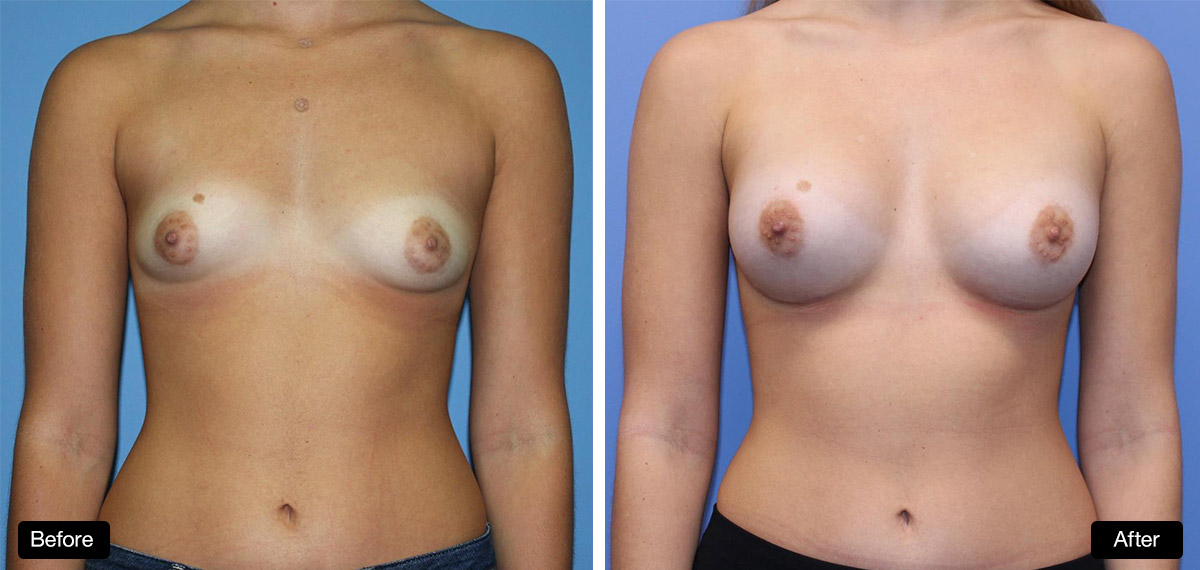
Breast Augmentation - 25 Year Old Patient Before & After
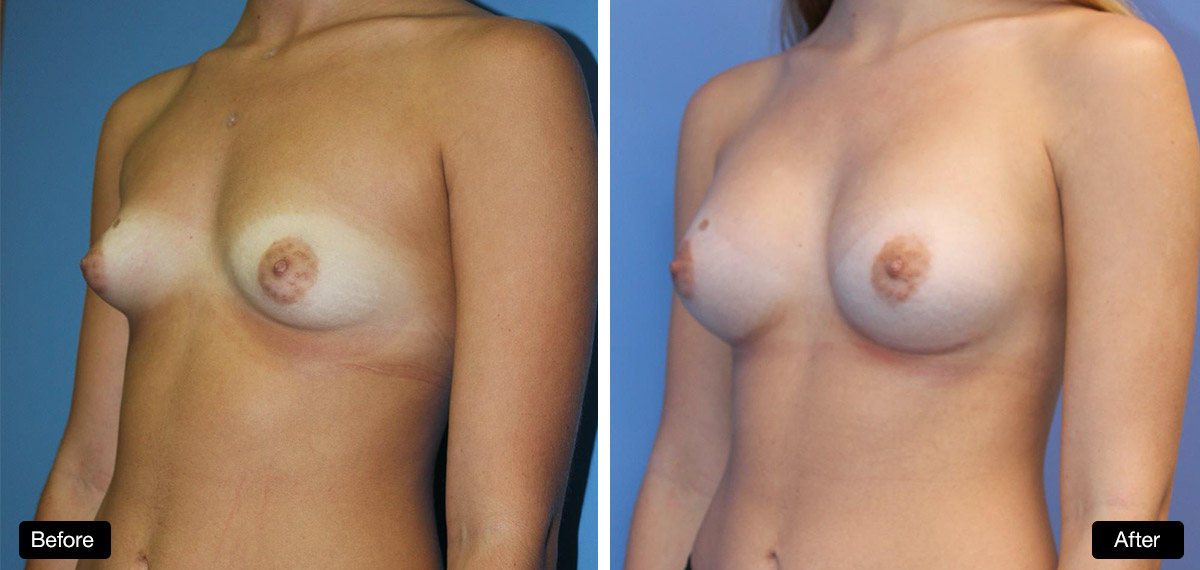
Breast Augmentation - 25 Year Old Patient Before & After
Case Example 2:
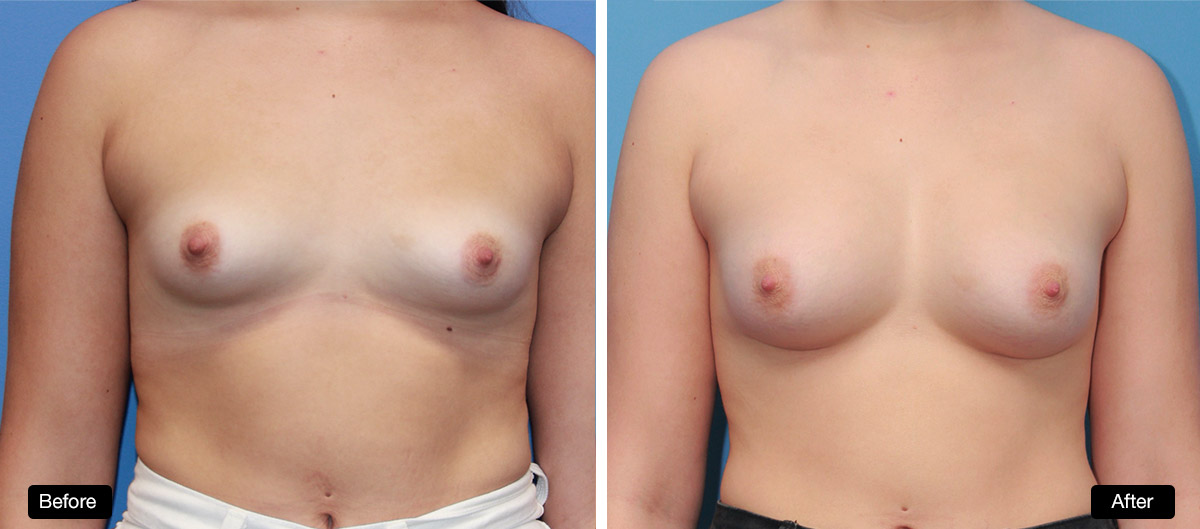
Breast Augmentation - 24 Year Old Patient Before & After
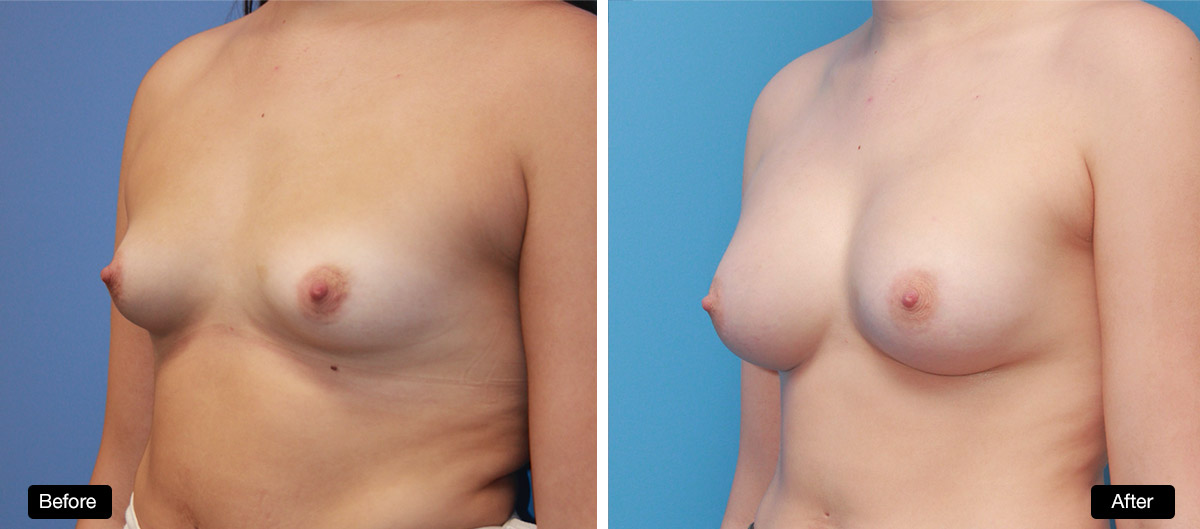
Breast Augmentation - 24 Year Old Patient Before & After
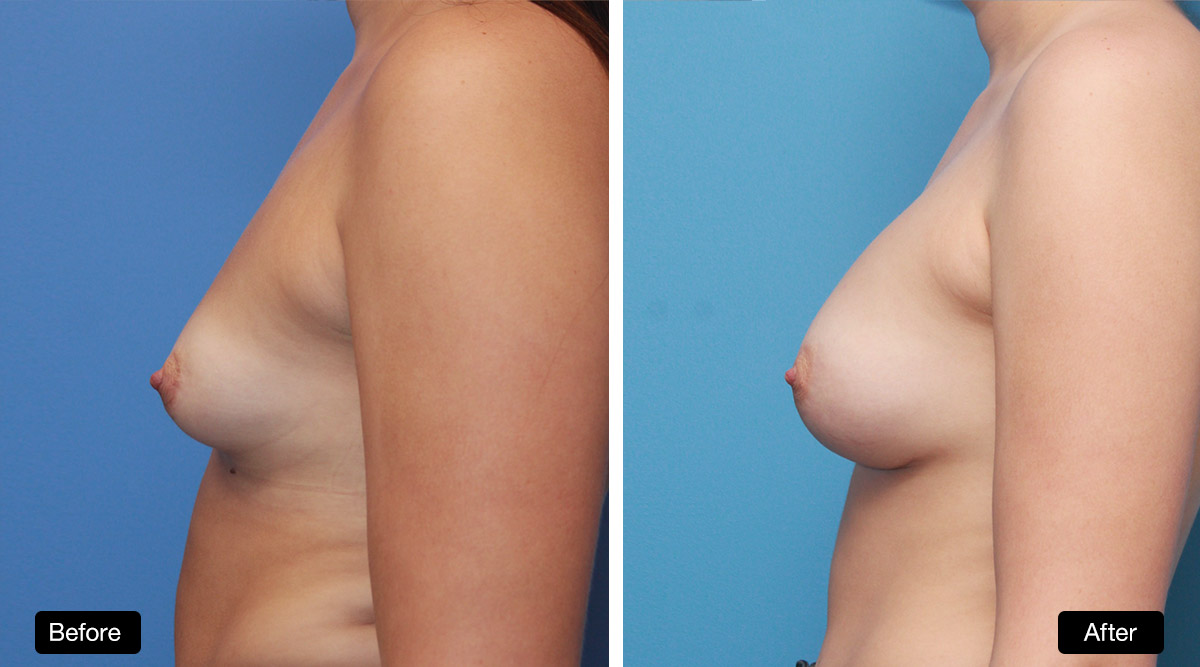
Breast Augmentation - 24 Year Old Patient Before & After
Frequently Asked Questions
Breast Augmentation Surgery
Will my breast implants last forever?
All breast implants have a lifespan and will not last forever. Therefore, if you are thinking about having breast augmentation surgery you will need to plan for replacement surgery later in life. The life of an average breast implant is usually somewhere between 10 and 15 years. As your body changes over your lifetime with the influence of hormones, pregnancies, menopause and weight gain or loss, the size of your original implants may become inappropriate over time for your changed shape and this too might cause a desired change in implants. Nothing lasts forever.
—
Why do some breast implants go hard?
Breast implants can go hard due to what is called “capsular contracture”. A capsule is caused by a build-up of scar tissue around the implant. This hardening is more common with the silicone filled breast implants, especially when they are positioned behind in front of the chest muscle. The risk of capsular contracture increases with time.
Whilst some of the newer textured implants claim to have a reduced rate of capsular contracture, they too are not without their problems as textured implants have been implicated in concerns about ALCL (Anaplastic large-cell lymphoma).
Where are the breast implants inserted?
The most common incision sites are under the breast, around the nipple or in the armpit. Breast implants have also been described as being inserted endoscopically through the navel (saline only).
The choice of incision site needs to be discussed with your surgeon as just with the type of implant. All incision sites have certain advantages and disadvantages. The preferred incision for Dr Lotz is in the crease under the breast, as this offers the best visualization and the scar hides nicely in the fold.
While the armpit avoids any potential scarring on or around the breast, it makes if very difficult to accurately place the implant, and has a high revision rate. Incisions around the nipple have a higher risk of issues with loss in nipple sensation. It also risks contamination of the implant from touching the breast tissue when it is inserted, which increases the risk of ALCL.
What would be a suitable breast implant for my thin build?
Both the type and size of breast implant that are appropriate for you depends not only on the shape and size you wish to achieve but need to be measured against your existing breasts and your chest wall to determine what will work best to give you the result you desire. Breast implants come in many shapes and sizes, all of which are factors in the ultimate shape and look.
Should my implants be under or over the muscle?
There are several factors that determine the best implant placement. For women who are very thin, generally placing silicone gel filled breast implants partly under the chest muscles is often a better choice to avoid implant show through the skin. Implants under the muscle have a lower risk of capsular contracture (hardening over time).
An implant placed in front the muscle is a little less painful initially, and allows better filling of the loose skin if needed. However, you need to make sure you have enough breast tissue or you risk visibility of the implant edge.
What type of implant do you prefer for breast enhancement?
I use Mentor, textured, silicone gel filled implants, as they have been in use for many years and have a proven safety record. They have a very low risk of ALCL compared to other implants, and I find the gel gives a very natural feel.
Should I have round or tear drop shaped implants?
This will be discussed in your consultation. Round implants will give more fullness to the upper part of the breast than anatomical implants. If you have no breast tissue at all, the final breast shape will be determined by the implant, so a tear drop (anatomical) implant will give the most natural result.
With careful selection of implant size and shape a natural look can be achieved, but this needs to also be looked at with respect to your body shape and how much breast tissue you already have.
What is ALCL?
Breast implant associated ALCL (anaplastic large cell lymphoma) is a cancer of the immune system caused by breast implants. It is generally found in fluid collection in between the implant and capsule, and usually presents as a swelling of the breast. It occurs in association predominantly with textured breast implants with a rate between 1 in 2200 and 1 in 86000 (American Society of Plastic Surgeons, October 2019). The average time from surgery to diagnosis is 8 years. Removal of the implant and the capsule is required and it usually has a good prognosis. As of March 2020, only 4 women in Australia have died from this in the last 10 years.
Dr Lotz uses predominantly Mentor implants which have a relatively low risk of ALCL.
Is there a danger of silicone implants leaking?
Silicone breast implants have come a long way. The implants are now filled with a highly viscous grade of silicone get that is similar in texture to ‘Turkish Delight’. This substance is more easily contained and removed should the implant rupture and leak. Because no implant will last forever and because small defects in implants may be undetectable for an unspecified period of time, it is recommended that women have regular annual check-ups. Any hardening, suspicions or irregular ultrasounds should be followed by an MRI for a definitive diagnosis. The average life span of all implants averages approximately 10 years and this need for further surgery should be factored into the decisions to have breast implants.
Can breast implants look natural?
Getting natural looking breasts with breast implants is possible. If a natural look is what is desired, then it is possible for an experienced breast surgeon working with the patient desires to choose the size, shape and position correctly and create a natural breast shape that is in balance with your body.
How long will it take to recover from breast augmentation surgery?
Most patients can return-to-work in one to two weeks after breast augmentation surgery. The time required may depend on how physically demanding the patient’s job is. Most patients will be back at office work in about a week, whilst more involved work may require 10-14 days off. Patients should avoid any strenuous activity for a month, but gentle exercise can be resumed after a couple of weeks. You will be back to full activity 6 weeks after the breast augmentation surgery.
How much does breast augmentation surgery cost?
Following your initial consultation with Dr Lotz, you will be provided with a detailed, personalised quotation which explains all the relevant costs pertaining to the breast enlargement procedure including all surgeon, anaesthetist and hospital costs.

